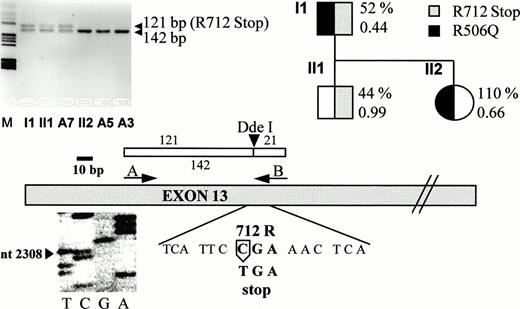To The Editor:
Pseudo-homozygous APC resistance1 is defined by finding the heterozygous factor V (FV) R506Q substitution (Leiden mutation,2 1691 G/A in the coagulation FV gene) in the presence of APC resistance ratios3 similar to those of FV Leiden homozygotes. Although partial FV deficiency, invariably present in this condition, could compensate for the thrombophilic defect, all of the few cases reported so far are thrombophilic patients. The nature of the mutations responsible for FV deficiency in pseudo-homozygous APC resistance is still elusive, and their identification would make possible a more accurate diagnosis than that based on coagulation assays.
We report here the case of a 57-year-old man with pseudo-homozygous APC resistance who has experienced four thrombotic episodes in the lower limbs since the age of 30: three deep vein thrombosis episodes, two spontaneous and one following knee surgery and immobilization, as well as a spontaneous superficial thrombophlebitis. His 24-year-old daughter, who has inherited the FV Leiden allele (Fig1), also developed a superficial thrombophlebitis at 17 years of age.
Family pedigree with plasmatic values (percentage of FV:c levels and APC ratio) and mutation detection by direct sequencing (bottom) or Dde I restriction (top). A3, A5, and A7 are asymptomatic subjects.
Family pedigree with plasmatic values (percentage of FV:c levels and APC ratio) and mutation detection by direct sequencing (bottom) or Dde I restriction (top). A3, A5, and A7 are asymptomatic subjects.
Direct DNA sequencing of FV exons and splicing junctions was used to search the whole FV gene for mutations. In the large exon 13 a heterozygous C to T transition at nucleotide 2308 was found (Fig 1) that affected the codon for Arg 712 (CGA), producing a stop codon (TGA) and premature termination of translation. The resulting truncated protein would lack the complete light chain (domains A3, C1, and C2). This nonsense mutation, inherited by propositus’ son (Fig 1), also caused the virtual absence of the non-Leiden mRNA, as demonstrated by the homozygosity for FV Leiden after sequencing the FV cDNA obtained from platelet RNA. These findings explain both FV deficiency and marked APC resistance, because impaired expression of the non-Leiden gene results in the only presence of FV Leiden molecules in plasma.
Several recurrent mutations have been found in CpG sites within the coagulation FVIII gene, which is very similar in size and structure to the FV gene. Because the FV 2308 C to T transition is located in a CpG site, the screening of 18 unrelated subjects selected4 for reduced FV levels (FV:C <70%) and potential carriers of FV deficiency was performed. A mutagenic (T to C, bold italic) reverse primer B (5′TCTTCCTGGTTCAATGATGAGTCTC3′, nt 2334-2309), which introduces a Dde I restriction site (Fig 1) in the FV allele carrying the mutation, was used in polymerase chain reaction amplification with primer A (5′CCTCCAGAATCTACAGTCATGGCT3′, nt 2182-2206).
One subject (A7 in Fig 1; FV activity, 51%; FV antigen, 44%) turned out to be heterozygous for the 2308 C to T transition. Eight-point FV gene haplotypes5 were constructed and compared in the propositus and in subject A7. The same unfrequent haplotype was found to underlie the mutation in both unrelated subjects, which suggests identity by descent.
The present report provides an insight into the molecular mechanism underlying marked APC resistance that results from the combination of a frequent gain-of-function mutation (FV R506Q) and a novel FV mutation (Stop at codon 712). This null mutation is not peculiar to pseudo-homozygous APC resistance but belongs to the pool of FV gene mutations present in the normal population.
ACKNOWLEDGMENT
Supported by Telethon, Italy (Grant No. E.675).


This feature is available to Subscribers Only
Sign In or Create an Account Close Modal